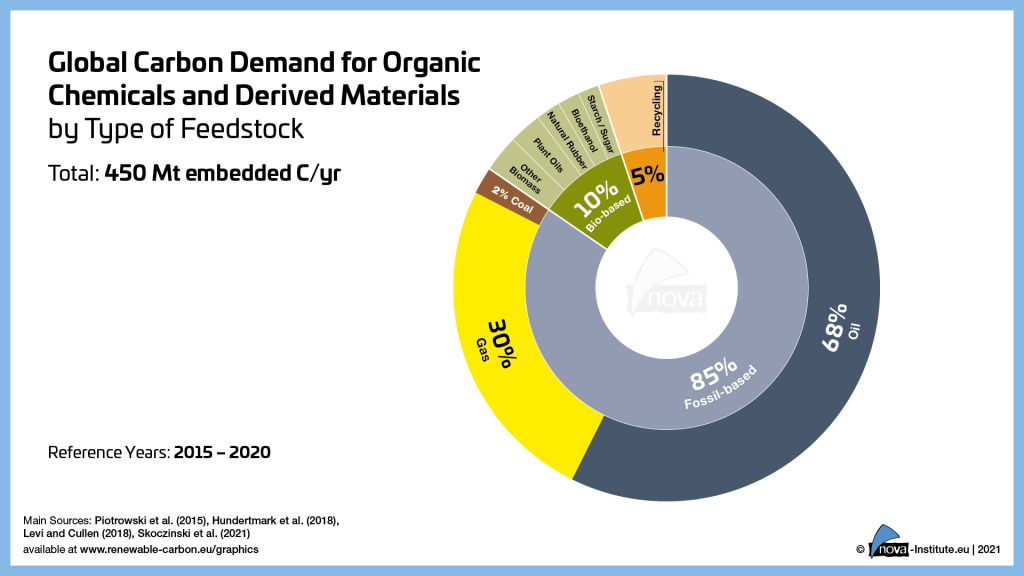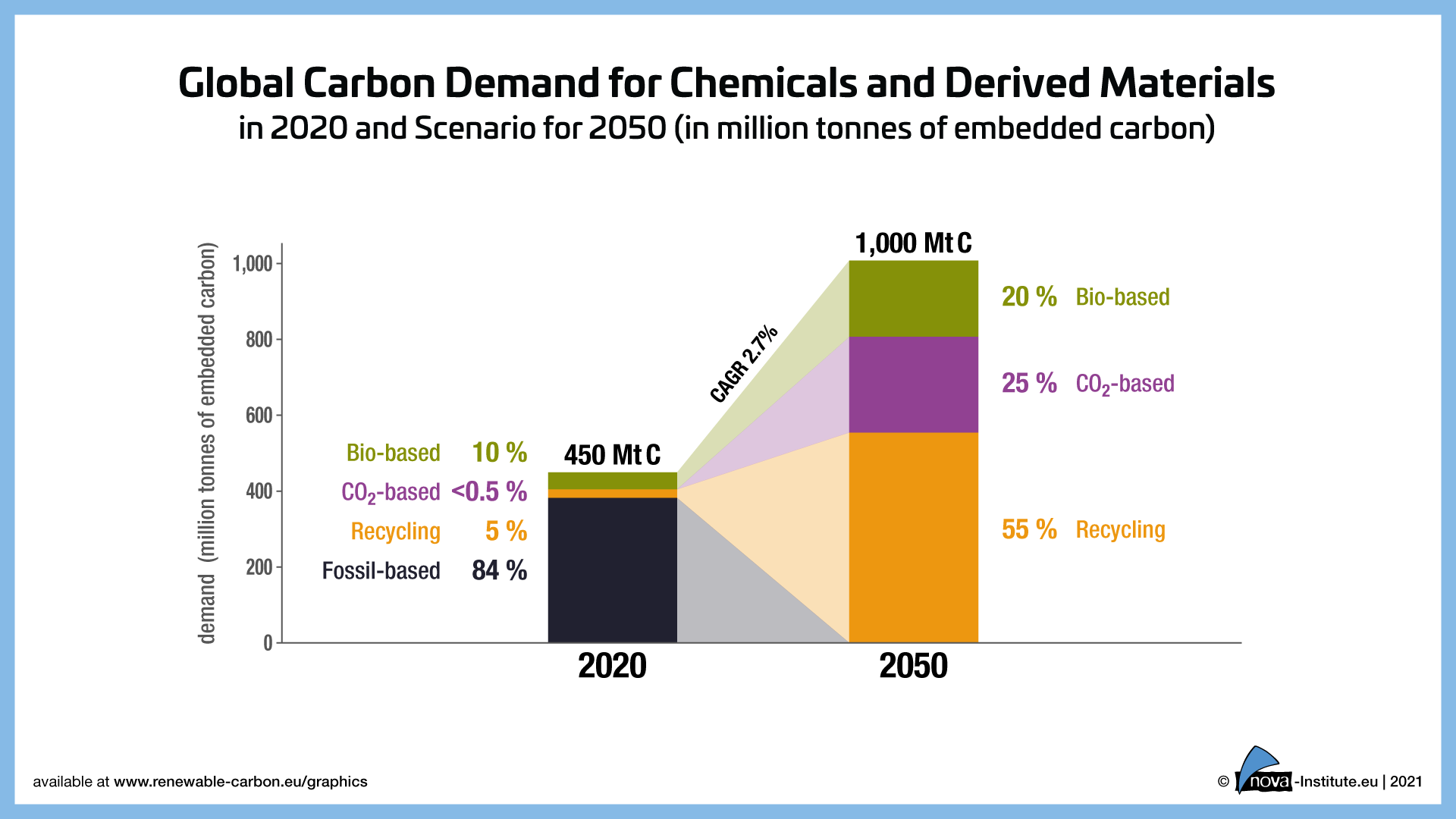In this new report, conducted by nova-Institute and commissioned by Unilever, the total carbon embedded in products from the chemical and derived material sector is examined on a global scale. This includes product groups like plastics, rubbers, textile fibres, detergents and personal care solutions. For the first time ever, the total global amount of embedded carbon is calculated, visualized and connected to the different feedstocks. Furthermore, end-user applications are investigated and depicted. The authors present a 2050 scenario is introduced that outlines prospects to transition from fossil to renewable carbon sources. Moreover, solutions for the highly interconnected chemical industry are illustrated together with supporting policy measures.
Visuals and PDF files in German and English available at: www.nova-institute.eu/press/?id=259

The report aims to raise awareness of the need for, and the technical, industrial and political feasibility of, the biggest transformation of the chemical and derived material sector since the industrial revolution.
Climate protection requires considerable efforts from the chemical and derived material sector
The climate crisis is accelerating at an unprecedented rate, with global warming, greenhouse gas emissions and deforestation causing food insecurity, global health concerns and biodiversity loss.
Greenhouse gas emissions linked to the use of fossil-based energy sources such as oil, coal and natural gas are the main factor contributing to climate change. It has become evident that we can no longer ignore the consequences that our current production methods have on the planet. To decarbonise the energy sector by 2050, and ensure the achievement of the goals set out under the Paris agreement, it is essential for the industry to completely phase out its use of fossil fuels.
But is that enough? Does it solve the climate problem?
The recently published report provides an analysis of the CO2 emissions that originate from the carbon embedded in commonly used products and commodities. It also shows how the chemical and material sectors can enact systems change to reduce their environmental footprints. At the end of their lifecycle, today, most of the embedded carbon ends up in the atmosphere in the form of CO2.
Chemicals and derived materials still strongly depend on fossil carbon
Products from the chemical and derived material sector surround us in manifold ways. For the first time, the amount of carbon contained in these products (embedded carbon) has been calculated. Of the annual demand of 450 million tonnes (Mt) per year, 85 % is generated by fossil-fuel-based resources, 10 % by biomass and only 5 % by recycling. To create long-lasting and sustainable change, three sources of renewable carbon can substitute the utilisation of fossil carbon: biomass, recycling, and CCU (Carbon Capture and Utilisation; captured CO2 from industrial processes or the atmosphere).

The demand for embedded carbon is set to rise. Increasing population, higher incomes and a growing middle class will drive the need for products and thus also for carbon. By 2050, nova-Institute estimates that the demand for carbon embedded in organic chemicals and derived materials will increase to 1,000 Mt per year. To achieve this demand sustainably, sharing, reusing and recycling play the main role in keeping carbon in a closed loop, in line with the Circular Economy. Chemical and mechanical recycling industries will be largely responsible for innovating their processes to better reuse and recycle carbon. Since keeping the entire carbon in a cycle is technologically not possible, additional renewable carbon sources such as biomass and CO2 capture and use become necessary.
For both options, sufficient land is available for either cultivation of biomass or the production of the required renewable energy for CCU. With these three renewable carbon sources (recycling, biomass and CCU) combined, it will be possible to keep using all the products we are used to without the need for any additional fossil carbon sourced from under the ground.

Renewable carbon for chemicals and derived materials
Contrary to energy, it is not possible to decarbonise chemicals and products. The renewable carbon family is the only pathway to a sustainable future for commonly used materials such as plastics, fibres, surfactants and other materials based on organic chemistry, and the industries that produce them.
The exclusive use of renewable carbon as feedstock is a key condition for the chemical industry to achieve climate neutrality. To achieve this, a comprehensive policy framework for carbon management is discussed, which is necessary to realise the revolutionary transformation of the chemical industry, within a timeline that is in accordance with our climate targets.
To cover the demand of the chemical and derived material sector, renewable carbon production will have to be increased by a factor of 15 by 2050. This highly laborious task will require cross-sector collaboration: industry, governments and consumers.
The study has been carried out on behalf of Unilever plc. and can be downloaded here for free: www.renewable-carbon.eu/publications/product/turning-off-the-tap-for-fossil-carbon-future-prospects-for-a-global-chemical-and-derived-material-sector-based-on-renewable-carbon/.
For questions, please contact:
Ferdinand Kähler (Staff Scientist Sustainability at nova-Institute)
ferdinand.kaehler@nova-institut.de
Source
Supplier
Share
Renewable Carbon News – Daily Newsletter
Subscribe to our daily email newsletter – the world's leading newsletter on renewable materials and chemicals









